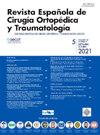骨盆内胸骨上髋臼板会影响术后X光片上的还原评估质量。回顾性病例系列。
Q3 Medicine
Revista Espanola de Cirugia Ortopedica y Traumatologia
Pub Date : 2025-05-01
DOI:10.1016/j.recot.2024.10.004
引用次数: 0
摘要
导言骨盆上板在髋臼骨折固定中发挥着重要作用。然而,这些植入物的形状可能会干扰使用普通 X 光片进行的复位评估质量。我们试图评估这种假象及其与 CT 结果的关系:在22例髋臼骨折的回顾性单中心系列研究中,由三名独立观察者对术后AP、髋臼臼壁和髋臼臼角X光片和CT图像进行了评估。科恩卡帕法(Cohen's kappa)用于检验观察者之间的可靠性:75.3%的病例中,胸骨上板干扰了负重面的评估,43.9%的病例中,所有三个斜切面都受到干扰。在46.9%的冠状切面和42.4%的矢状切面中,中央节段受到的干扰最为一致,这也是缩小不良率最高的区域:由于复位质量具有预后价值,是手术团队的必要指导,因此可以考虑将 CT 用于最具挑战性的髋臼骨折病例的术后检查。本文章由计算机程序翻译,如有差异,请以英文原文为准。
Las placas intrapélvicas suprapectíneas interfieren con la evaluación postoperatoria de la calidad de reducción por radiografía simple. Hallazgos sobre una serie retrospectiva de fracturas de acetábulo
Introduction
Intrapelvic suprapectineal plates play an important role in acetabular fracture fixation. However, the shape of these implants may interfere with the quality of reduction evaluations using plain X-rays. We sought to evaluate this artifact and its relationship with CT findings.
Materials and methods
In a retrospective, single-center series of 22 acetabular fractures, postoperative AP, alar and obturator X-ray views and CT images were evaluated by three independent observers. Cohen's kappa was used to examine interrater reliability.
Results
Suprapectineal plates interfered with the evaluation of the weight-bearing surface in 75.3%, and with all three oblique views in 43.9% of cases. The central segment was most consistently interfered with, corresponding to the area where the greatest malreduction was in 46.9% coronal and 42.4% of sagittal CT views.
Conclusions
Since the quality of reduction has prognostic value and is a necessary guide for the surgical team, that CT may be considered for the postoperative examination of the most challenging acetabular fracture cases.
求助全文
通过发布文献求助,成功后即可免费获取论文全文。
去求助
来源期刊

Revista Espanola de Cirugia Ortopedica y Traumatologia
Medicine-Surgery
CiteScore
1.10
自引率
0.00%
发文量
156
审稿时长
51 weeks
期刊介绍:
Es una magnífica revista para acceder a los mejores artículos de investigación en la especialidad y los casos clínicos de mayor interés. Además, es la Publicación Oficial de la Sociedad, y está incluida en prestigiosos índices de referencia en medicina.
 求助内容:
求助内容: 应助结果提醒方式:
应助结果提醒方式:


